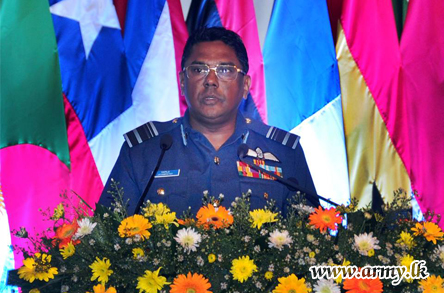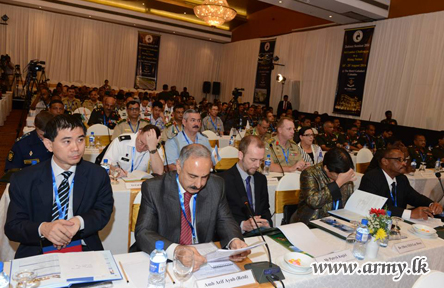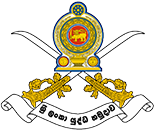 Spelling out the need to explore possibilities of reaching the maximum potentials in the sky as one of the main hubs on the road to development, Air Vice Marshal K.V.B Jayampathy, presenting his observations to the panel discussion on ‘Ensuring a Secure & Safe Airspace in Pursuit of Sri Lanka’s Ambition to Become the Aviation Hub of the Region,’ at the ongoing ‘Defence Seminar’ sessions announced that Sri Lanka Air Force, to be in line with most modern air technology, is now a fully-fledged service to meet with any air threats in the future.
Spelling out the need to explore possibilities of reaching the maximum potentials in the sky as one of the main hubs on the road to development, Air Vice Marshal K.V.B Jayampathy, presenting his observations to the panel discussion on ‘Ensuring a Secure & Safe Airspace in Pursuit of Sri Lanka’s Ambition to Become the Aviation Hub of the Region,’ at the ongoing ‘Defence Seminar’ sessions announced that Sri Lanka Air Force, to be in line with most modern air technology, is now a fully-fledged service to meet with any air threats in the future. Sri Lanka Air Force, as one of the most threatened services during the Eelam war, has now turned out to be a partner in the fast growing air travel industry with the expansion of new economic fronts, such as tourism, transport, etc.
Below appears the full text of his observations to the forum:
“It gives me a great pleasure to address a gathering of this caliber in this forum today. Moreover, I am delighted that I have been given the opportunity to talk on a subject of my professional area.
As we all know, Aviation has been a major driving force for the economies and being the fastest mode of state and transcontinental travel, has brought communities and cultures in to quickest and close contacts becoming an inevitable part of the cotemporary human relations. Technology and training has affected to strengthen the pivots between the man, machine and the environment on which the aviation industry is propelled to new heights.
Therefore for optimization of economic gains of aviation, far sighted policies, timely investment, efficient management, and providing safe and secure environment to keep potential threats away, have become vital requirements for any country.
Anyone with a slightest understanding on the world history will agree with me, if I say, Sri Lanka's strategic geographical location has commanded the trade routes in the Indian Ocean Region from the West to the East and vice versa from ancient times. The historic Silk Route, connecting the East with the West, had crossed Sri Lanka. As a result, there would have been plenty of trans-shipments routed via Sri Lanka even then.
Sri Lanka was relieved from a bitter separatism and terrorist war after thirty years in 2009 becoming an example to defeat terrorism completely. Aviation was one of the main industries that were being threatened by terrorism throughout the conflict. However post conflict social reintegration and peaceful environment has enabled Sri Lanka to fully focus on economic development. With respect to aviation, ensuring secure and safe airspace is a priority requirement for any nation as aviation has become a bridge of international economies.
Sri Lanka has identified aviation as a key economic growth area and has taken policy decisions to promote the country as an aviation hub in the region. As it has been a strategic port in the past, it has the potential to be an aviation hub that would be linking the regional air network benefitting Sri Lanka.
Here, I would be focusing on the following aspects of the topic.
- Sri Lanka’s Geopolitical Potential for aviation industry
- Post war economic development through sustainable peace
- Safety and security
- Political Will
His Excellency the President Mahinda Rajapaksa even before he came into power in 2005, had this concept of Sri Lanka as an Aviation Hub. He clearly spelt out this in his election manifesto - “The Mahinda Chintana”. Few years have passed and during this very short period Sri Lankan Aviation has worked towards achieving this aim. This includes landmark developments in aviation-related infrastructure such as launch of the Mahinda Rajapaksa International Airport (MRIA) in Mathhala.
As we all know, geography as well as peace and security are top priority for a viable aviation industry. The world has witnessed a few air line tragedies in the very recent past and they have reminded the whole world the inevitable need to keep the aviation business out of all possible threats emphasizing the need of keeping the air space peaceful for the civil air line operators. The recent tragedies of Malaysian airline MH 370(from KL to Beijing) and MH 17 (over Ukraine), attack on Karachchi international airport and overflying warning over conflict zones in Middle East have indicated that the threats are real and at times unpredictable. On the other hand it has gone to the extent of arming civil airlines with Anti Missile Systems or countermeasures as it has been reportedly done by Israelis.
In fact, the post war Sri Lanka is enjoying an extremely peaceful sky and Sri Lanka is proud to say that today, it’s a friendly sky for all operators for a healthy aviation business. The post war Sri Lanka has been characterized by a strong government with a greater Political Stability.
As I pointed out at the beginning, Sri Lanka’s ambition to become an aviation hub in the region derives with several potential aspects but its geographical potential being the number one. Strategically located at the hinge between the Bay of Bengal and the Arabian Sea, it is the Center-port between China and the Middle East.
Therefore from Colombo, all major Asian cities can be reached in approximately within 4 hrs. Further all European cities are within 8- 10 hours. It is also said that some of the market potentials also will bring favor for Sri Lankan aviation. For an example, nearly 50% of Airbus and Boeing Markets are targeting the Asia Pacific region in the coming years.
Also another fact that would be levering the industry is that Sri Lanka has began oil exploration in its widened EEZ, which will enable to strengthen its economy while being an added advantage for the Aviation industry of Sri Lanka.
Tourism; As it is well known in the past, after the war, Sri Lanka has again rapidly gaining attraction as a tourist hotspot. This would be a great potential for the aviation industry. Combination of International network and fusing that with domestic route network and enhanced accessibility would make a key facility for mutual growth in the tourism and aviation.
As you all know, a better aviation industry contributes for a viable economy. There are several key characteristics concerned for being an aviation hub, such as the Annual passenger and aircraft movements, Cargo handling and revenue to mention a few.
Capacity Building is an important area for one on the look out to be an aviation hub. Leading to this, Sri Lanka is already in the process of making simultaneous improvement on the following aspects such as,
• Development of aviation infrastructure
• Airline fleet modernization and expansion
• Improving local and international aviation affairs
• Expanding and improving aviation related functions and activities
Talking on the development, Ladies and Gentlemen, Sri Lanka already has 13 local airports in the country and we are on a process of adding two more to the network namely Palavi and Kandy in the near future.
Ladies and gentlemen, another important need is the fleet expansion. Sri Lankan Airlines, the national carrier aims to boost its fleet to 30 aircraft over the next few years. In April 2013, the government approval was given to acquire four Airbus A350-900 and six A330-300 aircraft to the fleet, with deliveries starting from 2014.
Also liberalization of the domestic aviation market, Domestic partnership to enhance network operations, launching of Budget air line and Promotion of amphibian operations are other aspects of aimed expansion.
Mihin Lanka, the budgetary air line is a major step bringing aviation to ordinary masses.
With that there were some improvements made by Sri Lanka to enhance the local and international aviation affairs.
- The National air carrier is Presently flying to 83 destinations in 39 countries
- New bilateral agreements with Kazakhstan, Azerbaijan, Spain, New Zealand, Ethiopia and Finland were signed.
- Sri Lankan Air has joined the elite One World club in 2014.
Ladies and gentlemen, Sri Lanka proposes a multitude of activities as depicted on the slide as a way forward in achieving the objective of Sri Lanka becoming an aviation hub in the region.
When talking on the safety and security, here I would like to quote a statement made by the Hon. Secretary of Def. and Urban Development Mr. Gotabaya Rajapakse. I quote, “without security and stability, there will be no economic development “I unquote.
With this in mind, it is important for us to give due consideration to the following:
• Aviation terrorism
• Unlawful interference
• Sabotage
• Using aviation for illegal activities
Ladies and Gentlement, Sri Lanka is responsible for an FIR that extends over 97500 Sq Km with Vertical Limits from Ground to 46000 ft and neighboring to FIRs of Chennai, Male, Medan and Melbourne and with the growth of the sector an efficient and safe traffic flow management is a necessity.
Keeping this in mind, for Optimization of Air Space for increasing traffic volume, Sri Lanka has been modernizing navigation and communication facilities such as Radar and HF to cover the entire Sri Lankan FIR. Further modern traffic monitoring and communication capabilities namely Automatic Dependence Surveillance-Broadcast, a system for efficient communication between pilots and air traffic controllers will be ready by early 2015.
Air Space surveillance and monitoring is essential for building a proper air Safety picture for efficient control. Currently radar monitoring is carried out by both Civil and Military radar capabilities. Apart from Colombo Area Control Centre, SLAF Radars too have the capability to track aircraft up to 200 NM and information is shared whenever required.
Ladies and gentlemen, talking about air and ground threat aversion and prevention, we enhanced the ground security apparatus at international and domestic airports in coordination with government forces law enforcement agencies which are already in place.
Continuous exchange of local and international intelligence assessments are performed regularly
Routine checks of all cargo / personnel at the terminals
Close coordination of emergency services are in place
Ladies and gentlemen, Further ADIZ is imposed and managed by Air Defence Control Centre of SLAF. This has further enhanced the air traffic monitoring and identification. The SLAF has a joint coordination mechanism with the civilian radar network. Compliance with AD Identification requirement is necessary for all operators and any unauthorized entries would be dealt as per the International regulations by SLAF.
When we are talking about ensuring a safe air space it is equally important to have well organized and efficient SAR mechanism in place. Search and rescue is one of the major aspects of aviation safety considerations. Sri Lanka is responsible for Search and Rescue within its FIR and the area. As mentioned earlier, it spreads approximately 97500 Sq Km.
Sri Lankan Disaster Management Center, a parliament approved establishment and it has a joint mechanism in coordination with Air Traffic Area Control Centre (ACC), SLAF, Navy, the Coast Guard and Maritime Environment Protection Authority to undertake SAR activities within the region.
With all the predictions on the growth in the industry, we have strongly felt the need to enhance our capabilities and the reach within the area of our interest. It is also influenced in the FIR as well as in the EEZ for prompt and effective response.
Sri Lankan Navy is improving its capabilities with recently established Coast Guard unit. Sri Lanka Air Force has already made initiatives to acquire suitable platforms that would be more maritime oriented with long range capabilities for SAR, as well as for policing and secure Sri Lankan interests. No need to remind that we had bitter lessons dealing with LTTEs global arms network that brought not only SAMs but even aircraft. We are optimistic that SLAF capabilities on SAR (Search & Rescue), ISR (Intelligence, Surveillance and Reconnaissance) and interception would grow fast. The need for such acquisitions is a long felt one and the government is in the process of acquiring a modern interceptor with all-weather capability and AEW (Airborne Early Warning platforms) to ensure safe and secure airspace.
Ladies and gentlemen, before I make the conclusive remark, I would like to focus your imaginations on the fact that the aviation technology has now on the focus of aerospace travel and tourism. Also the day would not be far away that ordinary people like you and me would be traveling on hypersonic unmanned capsules between continents provided that the safety and security kept the promises hundred percent. The industry which began a century back has realized an unimaginable dream for mankind with supersonic speed for everyone who thinks those hundred years of history is too short for that level of development in the industry. In fact aviation has achieved this thanks to the safety and security assured for all of us by the industry.
So any threat to the safety would inevitably lead for disasters, loss of lives, human and material cost, retarding growth, less profit or completely collapse of the industry. Sri Lanka has learnt with her past experience the need for keeping a better safety standard and enhances security for the aviation industry. Finally I would like to mention that, with all these planning efforts and achievements, Sri Lanka is highly ambitious of winning the blue skies in becoming an efficient safe and secure aviation hub in the region. The civil aviation sector and Sri Lanka Air Force together is fully committed to realize the ambition of Sri Lanka to become the aviation hub in the region through active contribution for the development of aviation and as being leading organizations, which ensure a safe and secure airspace for all others pursuing the same goal - to make Sri Lanka the regional aviation hub and finally to realize all our ultimate dream to make Sri Lanka, the wonder of Asia.”
 |
 |
 |

